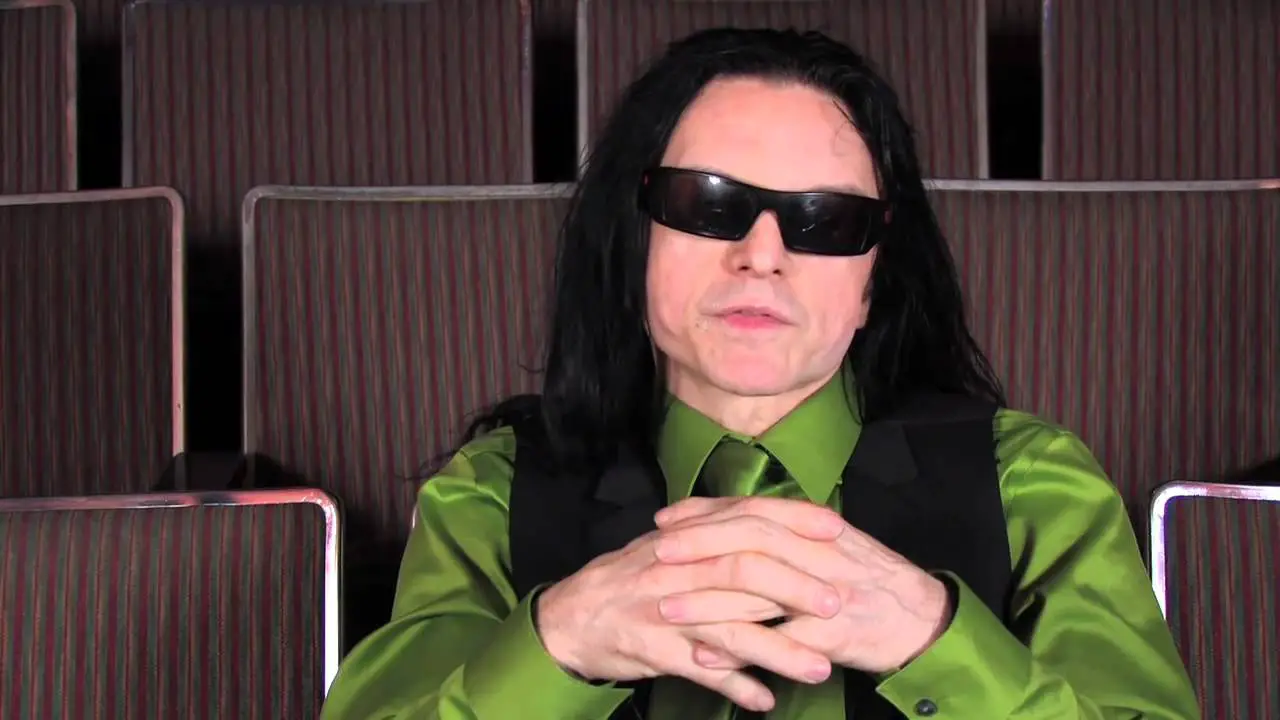On Feb. 24 I went to a screening of the world’s most beloved bad movie, “The Room.” The event, which was held in the Village East by Angelika Theater, was run by renowned writer, director and star of the film, Tommy Wiseau. Like live screenings of “The Rocky Horror Picture Show,” this event fully embraced the film’s poor reputation in mainstream cinema. Hundreds of excited movie-goers dressed in the iconic stylings of the film decorated the front plaza. But I came to this event with a different purpose. I didn’t just want to see the movie, I wanted to learn more about the madman behind it. I think this experience has solidified his presence as a force of pure, unadulterated chaos in the world of cinema.
“The Room” premiered in 2003 at the Laemmle Fairfax and Fallbrook theaters in Los Angeles. The film is set in San Francisco during the late ‘90s. It follows the protagonist Johnny (played by Tommy Wiseau), a successful banker who lives in a townhouse with his fiancee Lisa (Juliette Danielle). While Johnny showers his fiancee with affection and gifts, Lisa expresses dissatisfaction with her engagement and seeks out an affair with Johnny’s best friend Mark (played by Wiseau’s real-life friend Greg Sestero). The two begin a secret affair while Johnny, beginning to suspect Lisa’s unfaithfulness, grows increasingly agitated. After overhearing Lisa explain her adultery to her mother, Johnny attempts to find out who her new lover is by attaching a tape recorder to their house phone. Lisa progressively distances herself from Johnny, only confiding in her mother and best friend, Michelle, about her affair. Upset, Johnny seeks the help of his psychologist friend Peter, who also listens to Mark profess his guilt over his role in the affair.
While talking on the roof one day, Peter asks Mark if his affair is with Lisa; an outraged Mark attempts to kill him by pushing him over the ledge. The two reconcile and attend a surprise birthday party for Johnny a few days later. At the party, Lisa doesn’t attempt to hide her relationship with Mark, and she kisses him in front of everyone. Johnny is furious, and a fight breaks out between him and Mark. When Lisa conveys disgust at Johnny’s actions, he proclaims his disdain for the world and locks himself in the upstairs bathroom. From outside the bathroom door, Lisa tells Johnny of her love for Mark and her plans to run away with him. Distraught, Johnny waits until she leaves the room, then walks over to the tape recorder he planted on their phone and laments over the numerous adulterous calls between Mark and Lisa. Johnny experiences a manic episode filled with flashbacks of his time with Lisa. He grabs a revolver he’s stashed in a drawer and kills himself. Hearing the ruckus, Lisa finds Johnny’s corpse and expresses her sorrow over his death. Mark and Johnny’s friend Denny also run upstairs and mourn Johnny, though their sudden appearance is not explained. Mark says he is disgusted by Lisa when she attempts to mourn with him, and the film ends with all three crying over Johnny’s body.
The film is nothing short of melodramatic. Reading about it doesn’t give even the slightest idea of how absurd it is. From the horrific acting to the random plot points, the movie cements itself as a real contender for the world’s worst film. What is even more absurd than the film itself is the production behind it. The movie originally began as a novel written by Wiseau but was rejected by publishing companies due to its many plot holes and random bouts of pointless dialogue. Frustrated by this, Wiseau adapted the book into a film, which he decided to produce himself to maintain creative liberty. Its budget was an estimated $6 million, which Wiseau paid entirely out of pocket.
Greg Sestero details the chaotic nature of the production in his acclaimed 2013 memoir “The Disaster Artist.” According to Sestero, Wiseau wanted to break boundaries with this film. He purchased all the equipment and set pieces himself, and filmed the entire movie with 35 mm film and HD cameras, despite many production assistants warning him against using separate mediums. Wiseau went through with his decision despite the warnings, and had to hire twice the amount of crew members to operate the cameras and lighting fixtures. Sestero described Wiseau as overseeing the entire 400-person production like a tyrant. The actors became increasingly uncomfortable with his creative decisions. During one of the film’s four sex scenes, Wiseau insisted on walking around the set nude to stay in character. Sestero described the scene in his book: “In the love scene’s final shot, Johnny gets out of bed and walks bare-assed to the bathroom. Tommy thought long and hard about his decision to show his ass. ‘I need to do it,’ he told me. ‘I have to show my ass or this movie won’t sell.’”
All of the film’s insanity was channeled in the screening I attended on that fateful February evening. Before even approaching the theater, a huge crowd congregated in front of a merchandise table, where a 67-year-old Tommy Wiseau, in his iconic black shades and studded belt, stood behind a glass pane and took pictures with fans. Splayed out in front of him were heaps of bobble heads, toy footballs and various other props depicting various items from the film. To my surprise, there were also a few pairs of obnoxiously bright boxers, with the name “Wiseau” boldly printed on the waistband. Not only was there merch designed after the movie, but Wiseau had taken it upon himself to not-so-subtly sneak in some of his own apparel. The greatest souvenir of all was the entire script of “The Room,” printed the exact same way it had been when it was first adapted to a screenplay. I managed to snag the last copy, and after taking a photo with Wiseau, I got him to sign it for me.
The screening itself was, of course, chaotic. Running through center stage was Wiseau himself, shouting into his microphone for guests to line up and ask him questions. To no one’s surprise, every question asked only generated more confusion, as Wiseau gave jumbled replies that didn’t make much sense. My personal favorite interaction was when a film student asked how someone could muster the confidence Wiseau had to create their own film. Wiseau simply replied to this introspective question with “I love what I do, and you should love what you do. The world is about love, always do everything because of love.”
Despite this low-effort response, the crowd went wild, and soon a flurry of plastic spoons, catchphrases and confused shouting permeated the theater. I spoke to a few movie-goers who criticized these events, calling them blatant cash grabs on Wiseau’s part. While I can see that perspective, this particular night truly changed the way I thought of him as a creator. It’s easy to assume people like Wiseau are egotistical monarchs whose money and outrageous ideas are their driving sense of self. But that night, as the crowd erupted in applause with every incoherent thing that he said, I saw him as simply a guy who wanted to make a movie and did. No plans, no doubts, just a dream fueled by fervent passion. I can’t help but feel like that’s a bit remarkable. So if you ever find yourself in a discussion about bad movies and “The Room” is inevitably brought up, I don’t think it would hurt to give this crazy, discombobulated vision another thought.
















